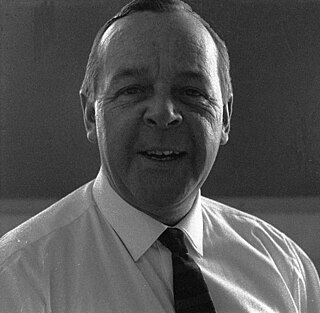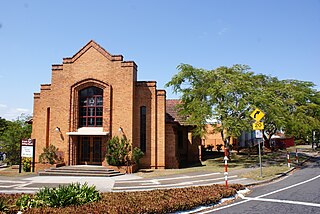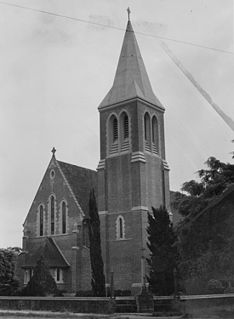Related Research Articles
Robin Gibson was an Australian architect, from Brisbane, Queensland.
James Birrell (1928-2019) was an architect responsible for the design of significant buildings in Queensland, Australia. James Birrell practiced from 1951 to 1986.

Daryl Sanders Jackson AO is an Australian architect and the owner of an international architecture firm, Jackson Architecture. Jackson also became the associate professor of the University of Melbourne and Deakin University.
Kerry Clare and Lindsay Clare are a wife and husband duo who are Australian architects, founders of Clare Design and joint recipients of the Australian Institute of Architects Gold Medal.
Pig City: Brisbane's Historical Soundtrack was a one-day music festival held as part of the Queensland Music Festival in 2007. The idea for the concert came from Queensland Music Festival Artistic Director for 2007 Paul Grabowsky, who was inspired after reading Andrew Stafford's book Pig City: From The Saints To Savage Garden. The festival was held on 14 July at The University of Queensland. It ran from midday to 10 pm.

Edwin James Hayes and Campbell Royston Scott were Australian architects who distinguished themselves through their use of colour and by re-thinking the concept of housing spaces.

The St Lucia Presbyterian Church is a heritage-listed church at 7 Hawken Drive, St Lucia, City of Brisbane, Queensland, Australia. Built in 1952, it was designed by Ronald Martin Wilson trading as R. Martin Wilson, Architect and Architectural Engineers. The church was originally commissioned for the St Lucia congregation of Presbyterians, subsequently becoming the property of the Uniting Church of Australia and now known as St Lucia Uniting Church. This church was the first substantial commission awarded to R. Martin Wilson after World War II. It is listed on the Brisbane Heritage Register.
John Harold Dalton FRAIA (1927–2007) was an English Australian architect, writer, editor and artist.
Rosemary Opala (1923–2008) was an Australian artist, writer and nurse, and is regarded for her work as a Queensland environmentalist, historian, social commentator and community activist.

George Landen Dann was an Australian playwright, writer, and draftsman. He is best known for a number of award-winning and critically acclaimed plays such as In Beauty It Is Finished, Fountains Beyond, Caroline Chisholm and The Orange Grove. Dann wrote dozens of published and unpublished plays over the course of his lifetime. Originally writing plays for the amateur dramatic society at Sandgate, Queensland, Dann was a particularly shy and reclusive person, and even though he wrote part-time, his more popular plays were widely performed by amateur theatre companies around Australia. George Landen Dann's writing has been appreciated for its social realism, with a number of his plays delving into issues involving Indigenous Australians and their central characters reflecting individuals that Dann had met during his time in outback Australia.

John H. Buckeridge (1857–1934) was an English-born Australian architect, who built about sixty churches in Queensland and is also remembered for remodelling the interior of the Macquarie era church of St James', King Street, Sydney.
John Dalton's (FRAIA) architectural career was chiefly distinguished by his extensive practice in domestic architecture, concentrated in the Western suburbs of Brisbane, Queensland, Australia. In a career that spanned four decades, and realised upwards of 80 residences.
Robert Harold Dickson was a South Australian architect. His many works contributed greatly to various aspects of South Australian architecture, ranging from conservation shelters to school buildings and residential projects. His most notable works are former premier, Don Dunstan's residence, the first townhouses in Adelaide and the University of Adelaide's Union House. He was described by Don Dunstan as the "premier architect".

Karl Langer (1903–1969) was an Austrian-born architect in Queensland, Australia. A number of his works are listed on the Queensland Heritage Register.

Cliffside Apartments is a heritage-listed apartment block at 76 Lower River Terrace, Kangaroo Point, City of Brisbane, Queensland, Australia. It was built from 1936 to 1937. It is also known as Cliffiside Flats. It was added to the Queensland Heritage Register on 27 February 2004.
Edwin Henry (Eddie) Oribin was an Australian architect who practised in Cairns, Queensland, Australia. A number of his works are now heritage-listed.
Peter Newell (1916–2010) was an Australian architect, who worked in the modernist tradition in Queensland and became an architectural critic.
Vitaly de Gzell (1908-1977) was a Russian-Australian architect, who practised in Queensland in the modernist tradition.

Gabriel Poole (1934–2020) was an internationally recognised, award-winning Australian architect, known for innovative, light-weight designs that are site and climate responsive. His ‘Tent House’ in Eumundi won the Royal Australian Institute of Architects (RAIA) Queensland Innovation Award, the Robin Dods Award and the RAIA National Robin Boyd Award in 1991. In 1998 Poole was awarded the nation's highest arch itectural award, RAIA Gold Medal, for his lifetime contribution to Australian architecture. He was also an advocate of housing affordability, pioneering low-cost, pre-fabricated designs.
References
- 1 2 3 4 5 6 7 8 9 10 11 12 Bryce, Jack (8 January 2004). "Architect followed sun and found Noosa style". The Courier Mail.
- ↑ Gatley, Julia and King, Stuart (2017). Brutalism resurgent. Routledge. ISBN 9781138652361.
- ↑ Hurst, Maurice (1966). Houses in retrospect - 1960-1966 : a personal view of the design process. University of Queensland Fryer Library: Unpublished.
- 1 2 3 4 Dennis, Peta, Avery, Tracey, & Whitman, Paula (2004). Cool: The 60s Brisbane house (PDF). School of Design and Built Environment, Q.U.T., Brisbane , Queensland. p. 20.
- ↑ Gardiner, Peter (14 August 2012). "Lifeguards soon to have a better view". Noosa News.
- ↑ "404". Archived from the original on 4 March 2016. Retrieved 1 May 2011.
{{cite web}}: Cite uses generic title (help) - ↑ "AA - EXHIBITION - November/December 2004". www.architecturemedia.com. Archived from the original on 22 July 2005.
- ↑ "Australia Day 2004 Honours". Commonwealth of Australia. Gazette. Special. 26 January 2004: 18.
- 1 2 University of Queensland Library, Fryer Library (2015). "UQFL211 Lund Hutton Ryan Morton Collection Finding Aid" (PDF). FRYER LIBRARY Manuscript Finding Aid.
- 1 2 3 University of Queensland Library, Fryer Library (2014). UQFL523 Fryer Library Maurice Hurst Collection Manuscript Finding Aid (PDF). University of Queensland Library, Fryer Library.